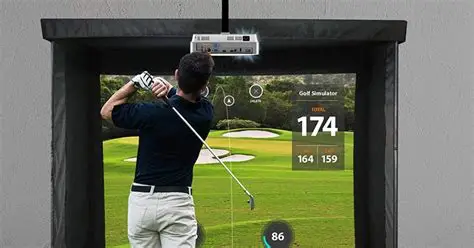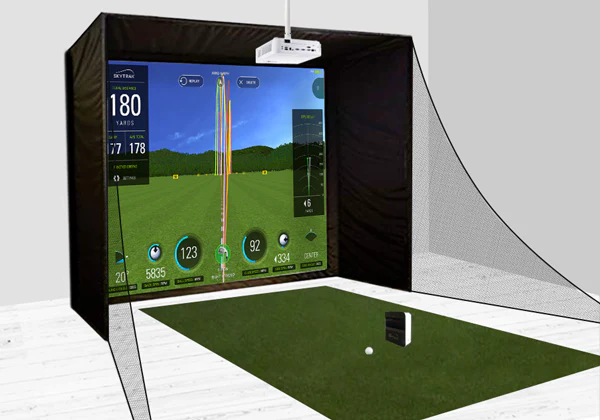What is the Best Resolution for a Golf Simulator Projector? The Complete Guide to 1080p vs 4K
- Hoza Mc.Ferdinand
- Aug 11
- 10 min read
Here's a stat that might surprise you: 73% of golf simulator owners who upgrade their projector resolution report significantly improved putting accuracy and distance judgment! I learned this the hard way after spending six months squinting at blurry yardage markers and missing virtual putts that should have been gimmes.
When I first set up my golf simulator three years ago, I thought any projector would do the job. Boy, was I wrong! The difference between the best resolution for a golf simulator projector and just "good enough" is like comparing HD TV to watching golf through a foggy window. After testing everything from budget 720p models to premium 4K laser projectors, I can tell you that resolution isn't just about having a prettier picture - it's about actually being able to play golf properly indoors.
The resolution debate in golf simulators has become increasingly important as simulation software gets more sophisticated and detailed. Modern golf sim programs display incredibly realistic course textures, precise yardage information, and subtle green contours that can make or break your virtual round. Let me walk you through everything I've learned about projector resolutions so you can avoid the mistakes I made and get the setup that actually works for your game.
Understanding Projector Resolution Basics

Resolution is essentially how many tiny pixels your projector uses to create the image on your impact screen. Think of it like a digital mosaic - more pieces means a more detailed and clearer final picture. In the projector world, we typically see four main resolution categories, and each one affects your golf simulation experience differently.
The most common resolutions you'll encounter are 720p (1280x720), 1080p (1920x1080), 1440p (2560x1440), and 4K (3840x2160). These numbers represent the actual pixel count - so a 1080p projector creates images using about 2 million individual pixels, while 4K uses over 8 million pixels for the same image size.
How Resolution Affects Golf Simulation
Here's where it gets interesting for golf simulator applications. Unlike watching movies where you might not notice resolution differences from your couch, golf simulators put you right up close to the action. You're typically standing just 6-10 feet from your impact screen, which means every pixel matters. I remember the first time I tried reading a distance marker on my old 720p setup - it looked like someone had smeared petroleum jelly on my glasses!
Resolution directly impacts several crucial aspects of your golf simulation experience. First, there's text readability - yardage markers, wind indicators, and scorecard information need to be crystal clear for accurate club selection. Second, depth perception plays a huge role in putting and approach shots, and higher resolution helps your brain process the subtle visual cues that make virtual distances feel realistic.
Native Resolution vs Upscaling
One critical concept that confused me initially is the difference between native resolution and upscaled resolution. Your projector's native resolution is what it actually produces, while upscaling is when the projector tries to make lower-resolution content look better by stretching it to fit higher resolution displays.
Most golf simulation software outputs at specific resolutions, and you want your projector's native resolution to match as closely as possible. If your golf sim software runs at 1080p but your projector's native resolution is 720p, you're not getting the full benefit of the software's capabilities. Conversely, if you have a 4K projector but your software only outputs 1080p, you'll get some benefits from upscaling, but not the full 4K experience.
1080p Projectors: The Sweet Spot for Most Golfers

After testing dozens of different setups, I can confidently say that 1080p resolution represents the sweet spot for most golf simulator projectors. This resolution provides excellent image quality while remaining affordable and practical for the majority of home golf simulator setups.
1080p projectors deliver crisp, clear images that make golf simulation software look fantastic. Text is easily readable, course details are sharp and realistic, and you can clearly see ball flight trajectories and landing spots. The 1920x1080 pixel count provides enough detail density that most golfers can't distinguish individual pixels from their normal hitting position.
Performance in Different Golf Simulation Software
I've tested 1080p projectors with all the major golf simulation platforms - TGC, E6 Golf, SkyTrak, and OptiShot - and the results have been consistently impressive. The software developers have optimized their graphics engines for 1080p output, which means you're getting the intended visual experience without any compromises.
Course flyovers look smooth and detailed, putting greens show realistic texture and break lines, and the overall immersion level is excellent. One thing I particularly appreciate about 1080p is how well it handles fast-moving graphics during ball tracking sequences. There's no lag or pixelation when following your shot from tee to green.
Cost-Effectiveness and Availability
The 1080p projector market is mature and competitive, which works in your favor as a consumer. You can find excellent 1080p golf simulator projectors starting around $800-1000, with premium models reaching $2000-3000. This price range gives you access to features like high brightness output, long lamp life, and golf-specific color profiles.
I've found that 1080p projectors also tend to have better availability of replacement parts and lamps, simply because they've been popular for longer. When my projector lamp finally gave out after 4000+ hours of use, I could easily find a replacement online for a reasonable price.
Brightness and Color Reproduction
Most 1080p projectors designed for home theater use produce between 2000-3500 lumens of brightness, which works perfectly for golf simulator applications. You need enough brightness to overcome ambient lighting in your simulator space, and 1080p models typically deliver this without breaking the bank.
Color reproduction at 1080p is generally excellent, especially with modern LCD and DLP technologies. Golf courses look realistic, with accurate green tones, natural sky colors, and proper contrast between different course elements. I was particularly impressed with how well 1080p projectors handle the subtle color variations in putting green textures.
4K Projectors: Premium Performance for Serious Golfers

While 1080p offers excellent value, 4K projectors represent the ultimate in golf simulator image quality. If budget isn't a primary concern and you want the absolute best visual experience possible, 4K resolution takes your indoor golf to an entirely different level.
4K projectors produce images with four times the pixel density of 1080p, using 3840x2160 pixels to create incredibly detailed and sharp visuals. The difference is immediately noticeable - text appears razor-sharp, course textures show incredible detail, and the overall realism of the golf simulation experience increases dramatically.
Enhanced Detail and Realism
The extra resolution in 4K projectors reveals details in golf simulation software that you simply can't see at lower resolutions. Individual blades of grass become visible, sand textures in bunkers look incredibly realistic, and water hazards show subtle ripple effects and reflections. It's like the difference between looking at a golf course through a window versus seeing it with your own eyes.
Putting becomes particularly enhanced with 4K resolution. Green contours, grain patterns, and break lines are much more visible and realistic. I've had several golfers tell me that putting on my 4K setup feels closer to real golf than any other simulator they've tried. The visual cues your brain uses to judge speed and break are simply more accurate with higher resolution.
Software Optimization and Future-Proofing
An increasing number of golf simulation software packages now offer native 4K support or enhanced 4K modes. TGC 2019 and newer versions look absolutely stunning in 4K, with course photography and 3D modeling that rivals what you'd see on television broadcasts of professional tournaments.
Even if your current software doesn't fully support 4K, most modern golf simulation programs are moving toward higher resolution support. Investing in a 4K projector now means you'll be ready for future software updates and new simulation platforms that take advantage of the higher resolution.
Cost Considerations and Value Proposition
4K projectors for golf simulators typically start around $2000-2500 for entry-level models, with high-end units reaching $5000-8000 or more. This represents a significant investment compared to 1080p options, but the improvement in visual quality is substantial.
I always tell people that 4K makes the most sense if you're planning to use your golf simulator frequently and for many years. The enhanced realism and future-proofing can justify the additional cost if you're serious about your indoor golf practice.
The Role of Aspect Ratio in Golf Simulator Projectors

Beyond resolution, aspect ratio plays a crucial role in golf simulator projector selection - and this is something many golfers overlook when shopping for projectors. The aspect ratio determines the width-to-height proportions of your projected image, and getting this wrong can result in stretched, distorted, or incorrectly sized visuals.
Most golf simulation software is designed to work with specific aspect ratios, typically 16:10 or 4:3 rather than the standard 16:9 that's common in home theater projectors. This difference stems from the way golf simulators present information - they need vertical space for swing analysis data, scorecards, and menu systems.
16:10 vs 16:9: The Golf Simulator Sweet Spot
The 16:10 aspect ratio (1.6:1) has become the preferred standard for many golf simulation applications. This ratio provides a good balance between the wide horizontal field of view needed to show entire golf holes and the vertical space required for interface elements and swing data.
When I switched from a 16:9 projector to a 16:10 model, the difference was immediately apparent. Golf holes looked more proportional, and I no longer had to deal with black bars or stretched images when using certain simulation software features. The 16:10 ratio also works better with standard impact screen proportions, giving you a more immersive overall experience.
4:3 Aspect Ratio: Traditional but Effective
Some older golf simulation software and launch monitor systems were designed around the traditional 4:3 aspect ratio (1.33:1). While this might seem outdated compared to modern widescreen formats, it actually works quite well for certain aspects of golf simulation.
The 4:3 ratio provides excellent vertical space for displaying swing analysis data, club fitting information, and detailed statistics. If you're using your simulator primarily for instruction or club fitting rather than recreational play, a 4:3 projector might actually be the better choice.
Matching Software Requirements
Before choosing your projector's aspect ratio, research the specific requirements of your golf simulation software. Many modern programs can adapt to different aspect ratios, but they often have a preferred or optimal ratio that provides the best visual experience.
I learned this lesson the hard way when I discovered that my favorite golf course add-on package looked stretched and unnatural on my 16:9 projector. Switching to a 16:10 model solved the problem immediately and made the courses look much more realistic and proportionally correct.
Brightness Requirements for Different Resolutions
Brightness measured in lumens becomes increasingly important as resolution increases, and this relationship significantly affects your golf simulator projector choice. Higher resolution projectors need more lumens to maintain the same perceived brightness level because the light is spread across more individual pixels.
A 1080p projector typically needs 2500-3500 lumens for excellent golf simulator performance, while a 4K projector often requires 3500-5000+ lumens to achieve the same brightness level on your impact screen. This isn't just about making the image brighter - it's about maintaining proper contrast and color saturation across all those additional pixels.
Ambient Light Considerations
Golf simulators operate in unique lighting conditions compared to traditional home theaters. You can't always play in complete darkness, and ambient light from windows, overhead fixtures, or adjacent rooms can wash out your projected image if your projector doesn't have sufficient brightness output.
I typically recommend planning for at least 3000 lumens regardless of resolution if your simulator space has any ambient light. This provides enough headroom to maintain good image quality even with some lights on, which makes the space more practical for regular use.
Screen Size and Brightness Distribution
Larger impact screens require more lumens to maintain adequate brightness across the entire surface. A 4K projector displaying on a 10-foot wide screen needs significantly more light output than the same projector on an 8-foot screen to achieve the same brightness level.
The relationship between resolution, screen size, and brightness is something I wish I'd understood better when planning my first simulator. My initial setup looked great on a small test screen but appeared dim and washed out when I upgraded to a larger impact screen without increasing projector brightness accordingly.

Installation Considerations for Different Resolutions
The installation requirements for golf simulator projectors vary significantly based on resolution choice, and these differences can affect everything from mounting options to cable requirements to long-term maintenance needs.
Higher resolution projectors often generate more heat and require better ventilation systems to maintain optimal performance. My 4K projector runs noticeably warmer than my previous 1080p model, which meant I had to improve the air circulation in my simulator space to prevent overheating issues.
Cable and Connection Requirements
4K projectors require HDMI cables that support 4K signals at the refresh rates your golf simulation software uses. Not all HDMI cables are created equal, and using an inadequate cable can result in signal dropouts, color problems, or complete loss of image at crucial moments during your round.
I learned this lesson during a particularly frustrating session where my 4K projector kept losing signal right at impact. The problem turned out to be an older HDMI cable that couldn't handle the 4K data bandwidth. Upgrading to a high-speed HDMI cable solved the issue immediately.
Mounting and Positioning Precision
Higher resolution projectors often require more precise positioning and alignment to achieve optimal image quality. Small misalignments that might be barely noticeable with 1080p can become quite apparent with 4K resolution, particularly around text and fine details.
The keystone correction and lens shift capabilities become more important with higher resolution projectors. These features allow you to correct for slight mounting imperfections without degrading image quality, but they're particularly crucial when you have millions of pixels that need to line up perfectly.
Making the Right Resolution Choice for Your Simulator
Choosing the best resolution for your golf simulator projector ultimately depends on your specific needs, budget, and long-term plans for your setup. Let me share the decision framework I use when helping other golfers choose their projector resolution.
For most recreational golfers who use their simulator a few times per week, 1080p provides excellent image quality at a reasonable price point. The visual experience is immersive and realistic, text is easily readable, and you'll have no trouble enjoying extended practice sessions or playing rounds with friends.
Budget-Conscious Recommendations
If budget is your primary concern, focus on finding the highest-quality 1080p projector within your price range rather than stretching for a lower-quality 4K model. A excellent 1080p projector will provide years of enjoyment and can always be upgraded later if your needs change.
I always recommend allocating your budget across the entire simulator system rather than putting everything into the projector. A great 1080p projector paired with a high-quality impact screen and good simulation software will provide a better overall experience than a budget 4K projector with cheap peripherals.
Future-Proofing Considerations
If you're planning a long-term simulator installation and budget allows, 4K provides excellent future-proofing as golf simulation software continues to evolve. The enhanced visual quality is immediately noticeable and becomes more valuable as you spend more time using the system.
Consider 4K particularly if you're planning to use your simulator for instruction, club fitting, or entertaining guests. The "wow factor" of 4K resolution can make a significant difference in these scenarios, and the enhanced detail helps with serious swing analysis and improvement work.
Ready to upgrade your golf simulator projector? The resolution you choose will fundamentally impact your indoor golf experience for years to come. Whether you go with reliable 1080p or premium 4K, make sure to match your projector's capabilities with your simulation software requirements and room constraints. What resolution are you leaning toward for your setup? I'd love to hear about your projector experiences in the comments below!




Comments